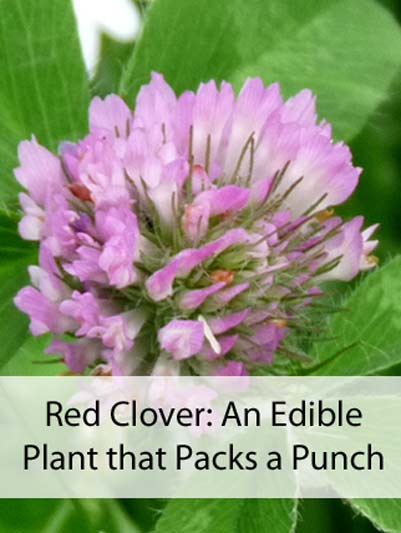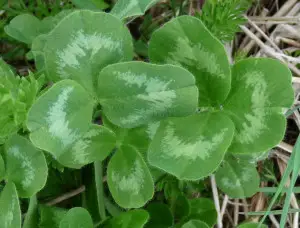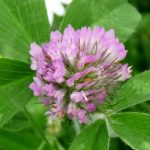 Red clover (Trifolium pratense) is a wild plant that many of us can easily recognize; and for countless individuals over the age of 60 they have fond memories of eating these sweet flowers as a child. In North America this is an edible plant that traditionally is thought of as nothing more than fodder for livestock and poultry, yet globally many cultures have incorporated this plant as food and medicine in their daily diet.
Red clover (Trifolium pratense) is a wild plant that many of us can easily recognize; and for countless individuals over the age of 60 they have fond memories of eating these sweet flowers as a child. In North America this is an edible plant that traditionally is thought of as nothing more than fodder for livestock and poultry, yet globally many cultures have incorporated this plant as food and medicine in their daily diet.
This common plant has quite a colorful history. Druids believed that red clover could ward off evil spells and witches, while Medieval Christians believed that the three-lobbed leaves were associated with the trinity and four-lobbed leaves were a symbol of the cross. Traditional Chinese herbalists believed that red clover tea made a good tonic for colds, to purify the blood, and at one time they even burned it as incense. Native Americans have used this plant as a salve for burns, as well as for bronchial problems. Many cultures worldwide have traditionally used red clover to treat whooping cough, respiratory problems, psoriasis, eczema, and yes, even cancer.
Red clover is one of about 250 species of the Trifolium genus. It is thought to have originated in southeastern Eurasia. For centuries red clover was primarily known as a wild plant until Albert Magnus (a Catholic Saint and philosopher) mentioned its cultivation in the 13th century.
Knowing what you can and can’t eat is an important part of being prepared. If you’re on a journey to live a more prepared lifestyle, you’ll enjoy [sc:getprep ] by Robin Edgerton and Angela England.
Red Clover as Food
Red clover leaves are pleasant to eat as they have a faint bean-like taste. They can be tossed into a salad or added to soups, stews, and other dishes such as lasagna. They can be used to make a tea; however, the preferable part of this wild edible is the flower. Red clovers are the tastiest of all clovers but be sure to go easy! Even though these are safe to eat, if you go overboard you just might experience bloating and gas.
This incredible plant is a great source of many nutrients including vitamins A, B1, B2, B3, and C. It also contains calcium, chromium, cobalt, magnesium, manganese, phosphorus, potassium, selenium, silicon, sodium, and zinc. Red clover is an incredible wild edible that is also a great source of protein, fat, as well as crude and dietary fiber.
Wait! I’m not done yet; red clover is an amazing source of isoflavones. Red clover’s isoflavones are a rich source of phytoestrogens, water soluble chemicals that act like estrogens in the body because of their ability to fit into estrogen receptors. They have strong antioxidant properties and here is the best part of all! Research conducted by the National Cancer Institute discovered that red clover contains four phytoestrogens: biochanin-A, formononetin, daidzein, and genistein. This may sound like a foreign language but, daidzein and genistein helps prevent the growth of cancerous tumors.
The red clover plant when fresh contains 82% water (5% when air-dried) and 12% sugars (fructose, glucose, rhamnose).
Finally, red clover contains tocopherol, a form of vitamin E, and some studies have linked a reduced risk of heart attack and cancer to vitamin E.
Storing:
Of course, like produce, eating red clovers fresh is best. There is a very simple way to store red clover leaves and flowers for the winter months. Harvest the leaf and flower separately. Dry them on a homemade screen in a dry room, or if preferred they can be dried in a dehydrator, or at a low temperature in the oven. Store dried plant material in mason jars so you can enjoy them throughout the winter months.
Red Clover for Your Health
Red clover does a fabulous job at helping to cleanse the spleen by removing dead red blood cells. The faster these are removed, the faster the body can regenerate new red blood cells, therefore increasing the body’s ability to prevent cancer. Red clover has been commonly used to relieve the symptoms of PMS in pre-menopausal women, and in place of hormone replacement therapy in menopausal women. Studies have suggested that red clover isoflavones are effective in reducing hot flashes, and they can delay bone loss associated with osteoporosis. Here is something that is exciting, red clover helps to reduce the levels of LDL (bad) cholesterol, and reduce the buildup of plaque that causes heart disease. This phenomenal wild edible has been used topically to help treat psoriasis, eczema and other skin conditions, and promotes healing of skin wounds.
How to Identify Red Clover

Accused of being a weed, this resilient plant is very common and you will discover this fascinating edible in areas very close to your home. Better still, the USDA map shows that this plant grows in every state and in every Canadian province. Great places to find red clovers include: fields, pastures, vacant lots, weedy meadows, and perhaps even in your front or backyard garden.
Red clover is very distinct as it has a reddish (or magenta) round flower head made up of numerous tubular-shaped flowers. Each flower head measures about ½” to 1” in diameter, but be careful as you pick these because the bees love pollinating this flower. Depending on your geographical location the red clover flower blooms about mid-May and can continue, depending on weather conditions, right through to late October. Typically this flower will die off in the hot summer months but makes a strong comeback in August.
Its green leaves have a white or pale green chevron on the upper side of the leaf and they are generally oval or ovate-shaped. At the base of each compound leaf, there is a pair of ovate stipules. Usually there are 1-3 leaflets immediately beneath each flower head, as well as several green bracts.
The stems are slightly hairy, hollow, and they tend to sprawl but they can also be erect. Depending on conditions, red clover plants can grow up to 30” in height.

Red Clover Blossom Syrup
Ingredients
- 4 cups red clover flowers
- 4 cups water
- 4 cups organic cane sugar
- ½ lemon or orange (organic if possible) chopped, (peel and all)
Instructions
- Put flowers and water in a pot. Simmer gently for about 20 minutes, turn off heat, cover, and let sit overnight.
- The next day, strain and press liquid out of flowers. Add sugar and sliced citrus and heat slowly, stir occasionally for several hours or until reduced to a thick, honey-like syrup.
- Can in 2 cup jars.
- This recipe makes a little more than 2 cups. I usually quadruple this recipe to share with others!
Notes
- The citrus is optional; it will give the syrup an orangey or lemony flavor. If you want the pure Red Clover flavor, you can omit the citrus.
So what are you waiting for?
Red clover is out there waiting for you to forage! You’ll soon discover the amazing benefits of this common plant!
My sister and I always hunted for red clover when we were kids to pull the petals out and suck on them since they taste like sugar. Fun to know the details, thanks!
My grandma always used to show us plants that we could pick and eat immediately – now I journal edible and medicinal plants. The more I learn about these plants, the more often I see them! Dead nettle is one that my sisters and I would suck the nectar from, and ‘sweet grass’ (as we called yellow wood sorrel) was fun to chew for a sour punch!
What is the best way to store this syrup?
On the counter ok?
★★★★★
Should I remove the pedals or can I use the whole flower? It seems time consuming to do that, but I don’t want them to be bitter!
We are going to make jelly from our vehicle and red clover this year. Came across some sweet yellow clover and we planted that at the end of our garden. Can it be used like the red and white clover?
Thank you
Sorry that is supposed to say white and red clover.
??♀️